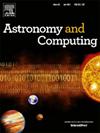利用SpArcFiRe的输出实现螺旋星系GALFIT模型初始条件的自动化
IF 1.8
4区 物理与天体物理
Q2 ASTRONOMY & ASTROPHYSICS
引用次数: 0
摘要
螺旋星系构成了在局部宇宙中观测到的星系的重要组成部分,但它们的特征结构尚未得到很好的理解。目前的分析方法依赖于人工干预和专业知识,这两者都对现代观测调查规模的螺旋结构的调查构成了重大障碍。我们提出了一个自动化的管道,它使用SpArcFiRe的简单的一维弧分析来生成GALFIT的初始猜测,以产生螺旋星系的二维光度分解。利用这个管道,我们对来自SDSS DR7数据发布的几个螺旋星系样本进行了二组分和三组分分解,这些样本是由Galaxy Zoo团队选择的。然后,我们评估我们的方法的性能,通过眼睛验证我们的结果,并分析这些批量参数化的结果。我们最大的样本是28912个星系,我们估计其中54%(约15700)的模型准确地映射了原始观测的可见结构。我们确定了ssamrsic指数、大小和臂与总通量比的趋势,并将这些趋势与以前的分解研究进行了比较,发现臂与总通量比大致一致。在其他参数中,有证据表明我们的模型与观测值过拟合,导致了分歧。最后,我们提出了一个扩展我们的方法,评估模型的俯仰角,因为它沿着手臂的长度变化。本文章由计算机程序翻译,如有差异,请以英文原文为准。
Towards automating initial conditions for GALFIT models of spiral galaxies using SpArcFiRe’s outputs
Spiral galaxies constitute a significant fraction of galaxies observed in the local universe yet their characteristic structure is not well understood. Current methods of analysis rely on manual intervention and expertise, both of which present a significant barrier to the investigation of spiral structure at the scale of modern observational surveys. We present an automated pipeline that uses the simple, one-dimensional arc analysis from SpArcFiRe to generate an initial guess for GALFIT to produce two-dimensional photometric decompositions of spiral galaxies. Using this pipeline, we produce two and three component decompositions of several samples of spiral galaxies from the SDSS DR7 data release, as selected by the Galaxy Zoo team. We then assess the performance of our method, validating our results by eye, and analyze the resultant parameterization of these in bulk. Our largest sample is 28912 galaxies, of which we estimate 54% (about 15,700) of the models accurately map the visible structure of the original observations. We identify trends in the Sérsic indices, magnitudes, and arm-to-total flux ratios, and compare these trends to previous decomposition studies, finding general agreement in the arm-to-total flux ratio. Of the other parameters, there is evidence that our models overfit the observations, causing disagreement. Finally, we present an extension to our method that evaluates the model’s pitch angle as it varies along the length of the arm.
求助全文
通过发布文献求助,成功后即可免费获取论文全文。
去求助
来源期刊

Astronomy and Computing
ASTRONOMY & ASTROPHYSICSCOMPUTER SCIENCE,-COMPUTER SCIENCE, INTERDISCIPLINARY APPLICATIONS
CiteScore
4.10
自引率
8.00%
发文量
67
期刊介绍:
Astronomy and Computing is a peer-reviewed journal that focuses on the broad area between astronomy, computer science and information technology. The journal aims to publish the work of scientists and (software) engineers in all aspects of astronomical computing, including the collection, analysis, reduction, visualisation, preservation and dissemination of data, and the development of astronomical software and simulations. The journal covers applications for academic computer science techniques to astronomy, as well as novel applications of information technologies within astronomy.
 求助内容:
求助内容: 应助结果提醒方式:
应助结果提醒方式:


